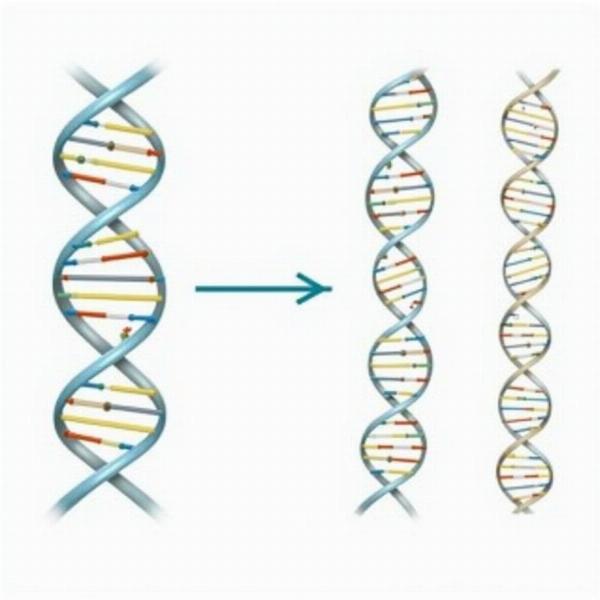Semiconservative replication is a fundamental concept in biology that describes how DNA replicates. Understanding its meaning in Hindi, अर्धसंरक्षी प्रतिकृति (ardhsamrakshi pratikriti), is crucial for anyone studying genetics or molecular biology. This article provides a detailed explanation of semiconservative replication, its significance, and related terms.
What is Semiconservative Replication?
Semiconservative replication ensures that each new DNA molecule consists of one original (parental) strand and one newly synthesized (daughter) strand. This process preserves genetic information while allowing for duplication. Imagine it like copying a valuable document: you keep the original and create a new copy, ensuring the information is passed on accurately. The term अर्धसंरक्षी (ardhsamrakshi) literally translates to “half-conserved,” perfectly capturing the essence of this replication mechanism.
![]() Semiconservative Replication Diagram
Semiconservative Replication Diagram
The semiconservative nature of DNA replication was confirmed by the Meselson-Stahl experiment, a landmark study in molecular biology. This experiment used isotopes of nitrogen to distinguish between old and new DNA strands, providing concrete evidence for the semiconservative model.
The Steps of Semiconservative Replication
Semiconservative replication involves several key steps:
- Initiation: The DNA double helix unwinds at specific points called origins of replication.
- Elongation: DNA polymerase, an enzyme, adds new nucleotides to the growing DNA strands, following the base-pairing rules (A with T, and G with C).
- Termination: The replication process ends when the entire DNA molecule has been duplicated.
Why is Semiconservative Replication Important?
Semiconservative replication is crucial for several reasons:
- Accurate Inheritance: It ensures accurate transmission of genetic information from one generation to the next.
- Cellular Growth and Repair: It allows cells to duplicate their DNA before cell division, enabling growth and repair.
- Evolution: The occasional errors during replication introduce genetic variations, which are the basis for evolution.
Semiconservative Replication vs. Other Models
Before the semiconservative model was established, other models were proposed:
- Conservative Replication: This model suggested that the original DNA molecule remains intact, and a completely new DNA molecule is synthesized.
- Dispersive Replication: This model proposed that the original DNA molecule is broken into fragments, which are then dispersed among the two new DNA molecules.
The Meselson-Stahl experiment definitively ruled out these alternative models, confirming the semiconservative nature of DNA replication.
Semiconservative Replication in Hindi Context
Understanding अर्धसंरक्षी प्रतिकृति (ardhsamrakshi pratikriti) is essential for students studying biology in Hindi. Many resources are available online and in textbooks to help grasp this concept.
Conclusion
Semiconservative replication, or अर्धसंरक्षी प्रतिकृति in Hindi, is a cornerstone of molecular biology. It ensures the accurate duplication of DNA, playing a vital role in inheritance, cell growth, and evolution. Understanding this process is crucial for anyone studying biology.
FAQ
- What does semiconservative mean? Semiconservative means that each new DNA molecule retains one original strand and one newly synthesized strand.
- What is the importance of semiconservative replication? It ensures accurate genetic inheritance, cell growth, and repair.
- Who proved the semiconservative model? Meselson and Stahl proved the semiconservative model through their experiment.
- What is the Hindi word for semiconservative replication? The Hindi word is अर्धसंरक्षी प्रतिकृति (ardhsamrakshi pratikriti).
- What are the other proposed models of DNA replication? Conservative and dispersive replication were other proposed models.
- What is DNA polymerase? DNA polymerase is an enzyme that adds nucleotides to the growing DNA strand during replication.
- What is the significance of the Meselson-Stahl experiment? It provided conclusive evidence for the semiconservative model of DNA replication.
Meaning-Hindi.in is your trusted partner for all your Hindi translation needs. We offer a wide range of services, including business and commercial document translation, certified and legal document translation, technical and user manual translation, website and localization translation, educational and academic document translation, express translation, and specialized translation services. Our expert team ensures accuracy, cultural sensitivity, and timely delivery. Contact us today for a free quote! Email: [email protected], Phone: +91 11-4502-7584. Meaning-Hindi.in is your one-stop solution for connecting with the Hindi-speaking world.
